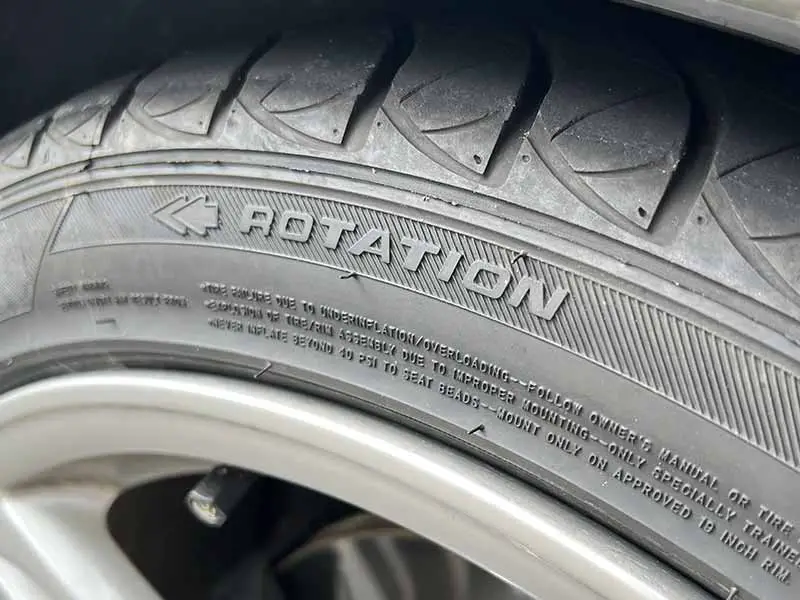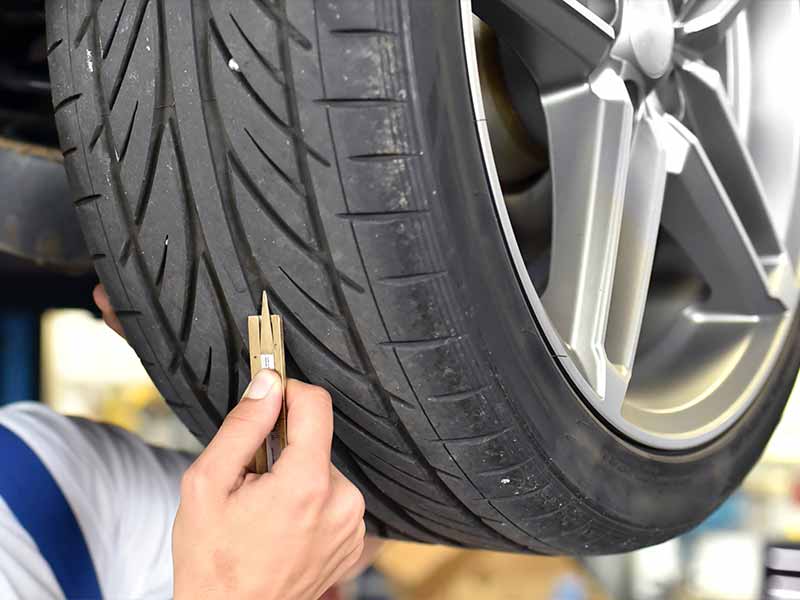Directional tires are typically excellent tires that are found on high performance vehicles. They are also great performers as all-season and all-weather tires. Directional tread patterns are amazing at shedding away water and preventing hydroplaning.
One of the side effects of direction tread patterns however is that they can’t be rotated normally. Tire rotation is important to tire life so they still must be rotated to get the most out of them.

How To Rotate Directional Tires
Directional tires must be rotated front to rear only and must not switch sides of the vehicle. If a directional tire is moved to the opposite side of the car or truck it will be spinning in the wrong direction when in motion and will not work as designed. This can lead to very unsafe handling, especially in wet weather.
Let’s cover the details of properly rotating directional tires and additional information you may need to know.
How Do I Know If My Tires Are Directional?
You can tell if your tires are directional by checking the sidewall for a directional tire arrow marking. This marking can take slightly different forms but the message should be clear.
Directional Tire Arrow
Can Directional Tires Be Rotated?
Directional tires can be rotated, but they can not be rotated using typical tire rotation patterns. Directional tread patterns can only spin in one direction. When a directional tire is mounted onto a wheel, it is locked into being used on only one side of your car or truck.
If you try to rotate a directional tire to the opposite side of your vehicle the tire will be spinning in the wrong direction and the tread will not be able to work as intended.
Some Say Directional Tires Cannot Be Rotated
While it’s true that directional tires can’t be rotated using typical tire rotation patterns such as the forward cross, rearward cross, or X-pattern, they can still be rotated front to rear.
Front to rear tire rotation is less than ideal but it is still quite effective. The majority of the benefits of tire rotation come from the wear pattern differences between front and rear axles.
Suspension geometries between these axles is very different and swapping tires front to rear will still create useful benefits.
Typical rotation patterns include crossing tires side to side. This helps to even out tread wear differences from one side to the other but these differences are very similar and the benefits are small.
Directional Tires Put On Wrong?
If directional tread patterns are not coming into contact with the road surface properly they can not work as designed. Often these tread patterns include a “V” shape or angled grooves that are designed to move water from the center of the tire and outward.
If the tire is mounted backward, the design will try to push water toward the center of the tire, which obviously is counterproductive and can create a dangerous situation.
Even in dry weather, the tires will not be able to perform as well as they could or should if they were mounted to spin in the correct way.
How To Rotate Directional Tires
The directional tire rotation pattern is very simple. You never move the wheels from one side of the vehicle to the other and simply swap the front and rear wheel assemblies on the same side of the car or truck.
Be sure to read our detailed article on how to rotate tires. All of the same steps apply regardless of the rotation pattern.
How To Rotate Staggered Directional Tires
When mixing directional tires and staggered wheel sets there is no good way to rotate tires. Directional tread patterns are not able to be rotated to the other side of your car or truck.
Staggered wheels are not able to be rotated front to rear. Staggered wheel sets have different sized wheels on the front and rear axles and are designed to be specifically used on a specific axle.
Since directional tires limit rotation front to rear and staggered wheels limit rotation side to side, there is no way to rotate your tires short of removing them from the wheels and remounting them reversed. Unfortunately, the benefit of doing this is negligible and not worth the expense or time required.
The best course of action with directional tires on staggered wheels is to not rotate tires. You can inquire with your tire manufacturer if they have a provision for how to deal with this scenario and still maintain your tire warranty.
In most cases, if the tire manufacturer allows for maintaining some tire warranty in this situation, they only guarantee 50% of the normal tire warranty mileage.
Can Directional Tires Cross Rotate?
Directional tires can no cross rotate because this would cause the directional tread pattern to spin in the wrong direction and not work as designed.
This can create a dangerous situation and should be avoided. The typical “V” grooves of most directional tread patterns are designed to shed water out and away from the center of the tire’s contact patch.
If the grooves are inverted, the water is forward toward the center and needs to find an alternate path and can create significantly worse traction in wet weather.
How Often To Rotate Directional Tires
Like with any tire, the tire manufacturer will require a certain rotation schedule to maintain the tire mileage warranty. Be sure and check the warranty paperwork that came with your tires to know specifically how often to rotate your specific tires.
In general, directional tires are rotated similar to non directional tires and benefit from being rotated every 5,000 miles. This usually meets or exceeds the tire warranty requirements.
What Happens If You Rotate Directional Tires?
As long as directional tires are rotated front to rear there will be do issues. If somehow they are accidentally rotated following the forward cross pattern, rearward cross pattern, or X-pattern, which are the most common tire rotation patterns, you will have at least two of the tires that have crossed to the other side of the car or truck.
You can check to see if this indeed the case by looking for the directional tire arrow marked on the sidewall of each tire. If the arrow is pointing forward on each tire you should have no problems.
If you find any tires that have the directional arrow pointed rearward, you should swap it over to the opposite side of your vehicle.
If you’re in a situation where there is an odd number of tires that have the directional arrow pointing in the wrong direction you will need to have one of the tires removed from the wheel and flipped so that the directional arrow is pointing in the proper direction.
Directional Tires Vs Non Directional
The most obvious difference between a directional tire and a traditional non-directional tire is the tread design. Directional tires typically have a “V” pattern or some other directionally oriented aspect to the tread that requires them to only spin in a certain direction to be effective.
Non directional tires can spin in either direction without sacrificing performance.
Directional tires typically are able to perform better than non directional tires but this comes at the cost of only being able to rotate them front to rear. They also tend to not last quite as long and non directional tires and can become louder as they wear.
The benefits of directional tread patterns are usually amazing wet weather performance and exceptional dry performance.
Do Directional Tires Wear Faster?
In general, directional tires do tend to wear out more quickly than traditional tire tread patterns. This isn’t always the case however. The Michelin CrossClimate 2 has a 60,000 mile tire mileage warranty which is on the higher end of tire warranty mileage guarantees.
Final Thoughts
Directional tires are great tires but they must only be rotated front to rear. Once a directional tire is mounted onto a wheel it can only be used on one side of the vehicle. Moving it to the other side of your car or truck will cause it to spin in the opposite direction the tread is designed to work.
It is possible to remove a directional tire and flip it on the rim so that it can be used on the other side, but this amount of effort isn’t worthwhile. The most benefit comes from rotating tires front to rear.
Resources
Below are some links you may find helpful when learning about tires






